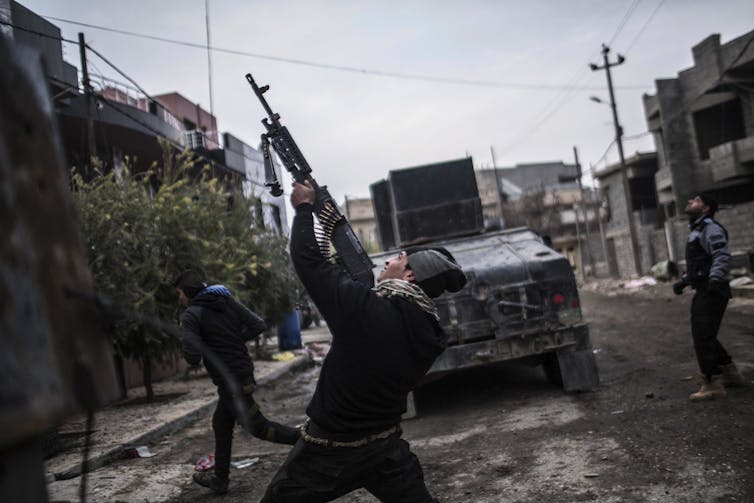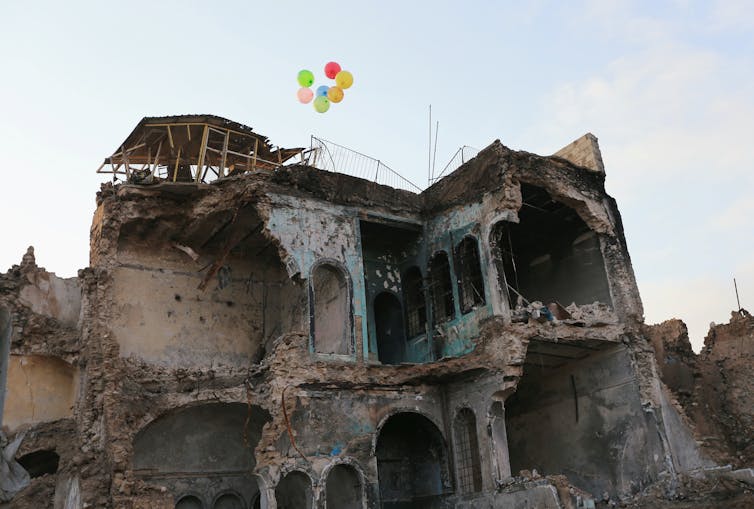Iraq's brutal crackdown on suspected Islamic State supporters could trigger civil war
- Written by Eric Keels, Research Associate at One Earth Future Foundation & Research Fellow at the Howard H. Baker Center for Public Policy, University of Tennessee
Large portions of the Islamic State[1] in Iraq have been either killed, captured or forced underground[2] over the past three years.
Eleven years after the U.S. invasion toppled dictator Saddam Hussein, triggering a war between Islamic State militants and the U.S.-backed Iraqi government[3], Iraq has finally achieved some measure of stability.
But the Iraqi government isn’t taking any chances that this terrorist organization, commonly known as “IS,” could regroup.
Over 19,000[4] Iraqis suspected of collaborating with IS have been detained in Iraq since the beginning of 2013, according to Human Rights Watch[5]. Most of them are Sunni Muslims, according to reporting by Ben Taub[6] of the New Yorker. Sunnis are members of the sect of Islam from which IS predominantly recruits.
Suspected terrorists are often tortured into offering confessions that justify death sentences at trial. According to Amnesty International[7], common forms of torture include “beatings on the head and body with metal rods and cables, suspension in stress positions by the arms or legs, electric shocks, and threats of rape of female relatives.”
The government’s crackdown on Sunnis – even those with no evidence of ties with Islamic militants – sends a troubling signal about Iraq’s prospects for peace.
Our research into conflict zones[8] shows that when post-war governments use violence against citizens, it greatly increases the risk of renewed civil war.
Repression following civil wars
The period after an armed conflict is fragile.
Citizens traumatized by violence wish fervently for peace. Defeated armed factions may have their sights set on revenge.
The post-war government’s priority, meanwhile, is to consolidate its control over the country. Sometimes,[9] leaders use violent repression[10] to ensure their grip on power.
It is a risky strategy.
We studied 63 countries where civil war occurred between 1976 and 2005, including El Salvador, Sierra Leone and Sudan. The results, which were published in the academic journal Conflict, Security and Development[11] in January, show a 95 percent increase of another civil war in places where governments engaged in the kind of torture, political imprisonment, killings and disappearances that Iraq’s government is now undertaking.
 The Iraqi Special Forces shoots at an Islamic State militant drone, December 2016.
AP Photo/Manu Brabo[12]
The Iraqi Special Forces shoots at an Islamic State militant drone, December 2016.
AP Photo/Manu Brabo[12]
Civil war is most likely to break out in former conflict zones if civilians believe they will be targeted by the state regardless of whether or not they actually support an insurgency.
Often, our results show, people respond to indiscriminate clampdowns by arming themselves. That is easy to do in conflict zones, which are home to many former rebels with extensive battlefield training and access to weapons[13], including both active militant groups and the remnants of vanquished insurgencies.
Assessing the risk of renewed war in Iraq
Sadly, Iraq has been down this road before.
In 2007, the U.S. military surge sent more than 20,000 additional American troops into combat[14] in Iraq to help the government of Nuri al-Maliki[15] – which came to power after Hussein’s demise – fight Al-Qaida and other Islamic militants.
The U.S. enlisted Sunni insurgents to help them find, capture or kill Al-Qaida operatives[16] during this period of the Iraq war, which is often called “the surge.”
That decision inflamed the centuries-old sectarian divide[17] between Iraq’s two dominant religious groups, Sunni and Shia Muslims.
 Iraqi Prime Minister Adel Abdul Mahdi leads a Shia-dominated government.
ACMCU/Twitter, CC BY[18][19]
Iraqi Prime Minister Adel Abdul Mahdi leads a Shia-dominated government.
ACMCU/Twitter, CC BY[18][19]
During former Iraqi President Hussein’s rule, Sunni Muslims controlled the country, and his government actively repressed Shia citizens. Since Hussein’s ouster, however, Iraq’s government has been run by Shia Muslims.
After the U.S. withdrew its troops in 2011, the U.S.-backed al-Maliki government began a brutal campaign to consolidate its authority[20]. From 2012 to 2013, he expelled all Sunni officials[21] from Iraq’s government and silenced opponents[22] using torture, political imprisonment, killings and disappearances.
At the time, our study of renewed fighting in conflict zones had just begun. The preliminary findings made us concerned that al-Maliki’s use of violence[23] to assert control over Iraq could restart the civil war by pushing angry Sunnis into the arms of militant groups.
Unfortunately, we were right.
Starting in 2014, the Islamic State began moving swiftly from Syria – where it was based – to conquer major cities across neighboring western Iraq.
Iraqi Sunnis, who were excluded from politics after Hussein’s overthrow and fearful of government repression, did little[24] to stop the incursion. Islamic militants increased their recruitment among Iraqi Sunnis by promising a return to Sunni dominance[25] in Iraq.
Many Sunnis took up arms against their own government not because they supported IS’s goal of establishing an Islamic caliphate across the Middle East but because they hated al-Maliki’s administration[26].
By June 2014, the Islamic State had captured Mosul[27], Iraq’s second-largest city, just 250 miles north of Baghdad. It took three years of fighting and the combined force of Iraqi, U.S. and Kurdish troops, as well as Iranian-backed militias[28], to rid the country of this terrorist organization.
In September 2017[29], Prime Minister Adel Abdul-Abadi claimed victory over IS in Iraq. The international community turned its focus toward Syria, where Islamic militants were continuing their war on citizens and the government.
 The Iraqi city of Mosul was almost destroyed in the government’s all-out military assault against IS.
Reuters/Ari Jalal[30]
The Iraqi city of Mosul was almost destroyed in the government’s all-out military assault against IS.
Reuters/Ari Jalal[30]
What’s next for Iraq
Still, the Islamic State remains a persistent and legitimate threat to both Syria and Iraq, with some 30,000 active fighters in the region[31]. Its commanders have reportedly buried large stockpiles of munitions in Iraq in preparation for renewed war.
American intelligence officials have warned against President Donald Trump’s plan to withdraw U.S. troops from Syria[32], saying it will give IS more freedom to regroup[33] there and in Iraq.
The Iraqi government’s crackdown on Sunnis is, in part, an effort to eliminate this threat, since IS could draw renewed support from disaffected Sunni Iraqis across the border.
But many observers think Prime Minister Abdul-Mahdi is also exacting revenge[34] on Sunnis for previously joining IS in armed warfare against Iraq’s government.
Rather than prevent more fighting, our research suggests, Iraq’s clampdown on Sunnis may spark another civil war.
References
- ^ Islamic State (theconversation.com)
- ^ killed, captured or forced underground (www.nytimes.com)
- ^ U.S.-backed Iraqi government (www.reuters.com)
- ^ 19,000 (www.apnews.com)
- ^ Human Rights Watch (www.hrw.org)
- ^ Ben Taub (www.newyorker.com)
- ^ Amnesty International (www.amnesty.org)
- ^ research into conflict zones (www.tandfonline.com)
- ^ Sometimes, (www.tandfonline.com)
- ^ use violent repression (www.eastwestcenter.org)
- ^ Conflict, Security and Development (www.tandfonline.com)
- ^ AP Photo/Manu Brabo (www.apimages.com)
- ^ extensive battlefield training and access to weapons (journals.sagepub.com)
- ^ 20,000 additional American troops into combat (www.nytimes.com)
- ^ Nuri al-Maliki (www.cnn.com)
- ^ Sunni insurgents to help them find, capture or kill Al-Qaida operatives (foreignpolicy.com)
- ^ centuries-old sectarian divide (www.pewresearch.org)
- ^ ACMCU/Twitter (i1.wp.com)
- ^ CC BY (creativecommons.org)
- ^ began a brutal campaign to consolidate its authority (www.washingtonpost.com)
- ^ expelled all Sunni officials (www.nytimes.com)
- ^ silenced opponents (www.nytimes.com)
- ^ al-Maliki’s use of violence (www.reuters.com)
- ^ did little (www.pbs.org)
- ^ promising a return to Sunni dominance (www.nytimes.com)
- ^ hated al-Maliki’s administration (www.npr.org)
- ^ captured Mosul (www.theatlantic.com)
- ^ Iranian-backed militias (www.pbs.org)
- ^ In September 2017 (www.nytimes.com)
- ^ Reuters/Ari Jalal (pictures.reuters.com)
- ^ 30,000 active fighters in the region (www.washingtonpost.com)
- ^ warned against President Donald Trump’s plan to withdraw U.S. troops from Syria (www.nytimes.com)
- ^ give IS more freedom to regroup (www.nytimes.com)
- ^ exacting revenge (www.newyorker.com)
Authors: Eric Keels, Research Associate at One Earth Future Foundation & Research Fellow at the Howard H. Baker Center for Public Policy, University of Tennessee

